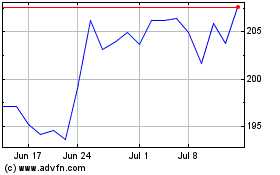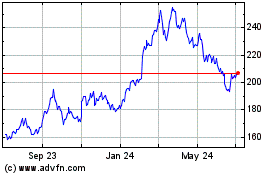Toyota Starts Trial of a Hybrid Power Generation System
April 26 2017 - 1:16AM
JCN Newswire (English)
Toyota Motor Corporation has begun trial operations of the
pressurized combined power generation system which has been
installed at Motomachi Plant in Toyota City, Aichi Prefecture. The
hybrid power generation system combines the use of solid oxide fuel
cells (SOFC)(1) (hereafter, "fuel cells") and micro gas
turbines(2). The trial operations will utilize the system as an
internal power generation facility, with the aim of testing and
evaluating the system's energy efficiency, performance, and
durability.
The hybrid power generation system uses hydrogen and carbon
monoxide which have been extracted by reforming natural gas, and
employs fuel cell technology and micro gas turbine in its two-stage
power generation mechanism, with a rated output of 250 kW. In
addition, it has a cogeneration system (combined heat and power)
that uses the waste heat produced in power generation.
This hybrid system achieves high generating efficiency (55%)(3)
with its two-stage power generation system, and also increases
overall efficiency (65%) by using the cogeneration system. For this
reason, Toyota has positioned it as an effective technology that
would help to realize the goal of achieving a low-carbon society.
The electricity and waste heat generated is used within Motomachi
Plant.
The newly introduced hybrid power generation system is being
implemented as part of the "Technological Demonstration for
targeting Mass-production of Pressurized Hybrid Power Generation
System Consisting of Cylindrical Solid Oxide Fuel Cell (SOFC) and a
Micro Gas Turbine (MGT)"(4) of the New Energy and Industrial
Technology Development Organization (NEDO). This system was jointly
developed by Toyota, Toyota's subsidiary, Toyota Turbine and
Systems Inc., as well as Mitsubishi Hitachi Power Systems Ltd.
Toyota will continue to promote the development and introduction of
the efficient utilization of hydrogen technology in plants, while
continuously monitoring the results of the introduction and
demonstration results of this hybrid power generation system. This
represents a progress forward in terms of initiatives targeted at
reaching zero CO2 emissions in plants, which is one aspect of the
Toyota Environmental Challenge 2050 which had been announced in
2015.
Reference: Difference between fuel cells
http://www.acnnewswire.com/topimg/Low_ToyotaFuelCells.jpg
Overview of the hybrid power generation system
http://www.acnnewswire.com/topimg/Low_ToyotaHybridPower.jpg
1. Natural gas (CH4) is reformed within the fuel cell, and hydrogen
(H2) and carbon monoxide (CO) are extracted.
2. Electricity is generated in the fuel cell through a chemical
reaction that occurs between the hydrogen and carbon monoxide with
the oxygen (O2) that is contained in the compressed air delivered
by the micro gas turbine. .
3. Waste fuel that is unused in fueled power generation (H2 and CO)
is delivered to the micro gas turbines together with the heat and
high pressure exhaust that is produced during power generation.
.
4. The waste fuel is burned in the micro gas turbines, and
electricity is generated as it rotates. . 5Waste heat is collected
from the exhaust gas produced during the burning process.
(1) Solid oxide fuel cells use ion conductive ceramic as an
electrolyte, allowing for operating temperatures between
700degC-1,000degC.
(2) A very small sized gas turbine with a small power output.
(3) Equivalent to the amount of electricity remaining after power
used in the station (for operation of equipment used in power
generation) is subtracted from the amount of power generated.
(4) In aiming to put SOFC into practical use for commercial and
industrial use, NEDO provided subsidies for R&D and
introduction of SOFC.
NEDO website http://www.nedo.go.jp/english/index.html
About Toyota
Supported by people around the world, Toyota Motor Corporation
(TSE:7203; NYSE:TM), has endeavored since its establishment in 1937
to serve society by creating better products. As of the end of
December 2013, Toyota conducts its business worldwide with 52
overseas manufacturing companies in 27 countries and regions.
Toyota's vehicles are sold in more than 170 countries and regions.
For more information, please visit www.toyota-global.com.
Source: Toyota
Contact:
Public Affairs Division
Global Communications Department
Toyota Motor Corporation
Tel: +81-3-3817-9926
Copyright 2017 JCN Newswire . All rights reserved.
Toyota Motor (NYSE:TM)
Historical Stock Chart
From Mar 2024 to Apr 2024

Toyota Motor (NYSE:TM)
Historical Stock Chart
From Apr 2023 to Apr 2024
